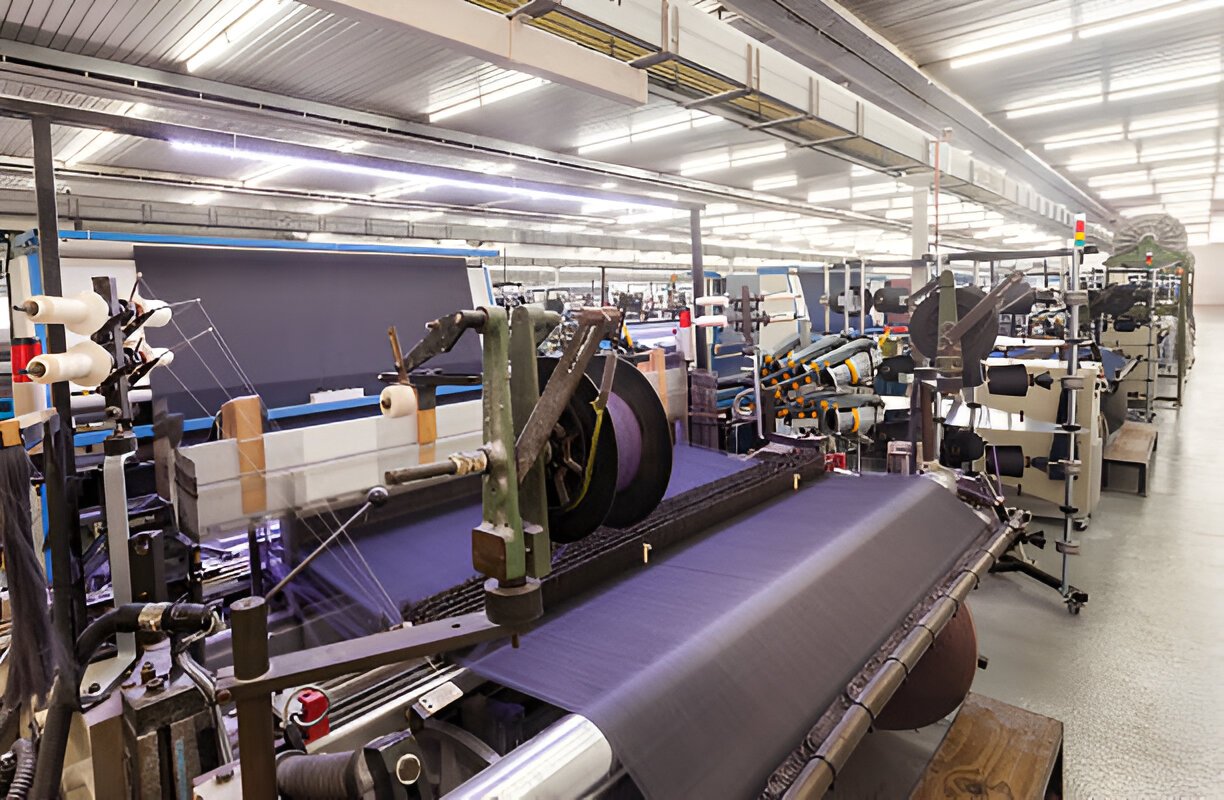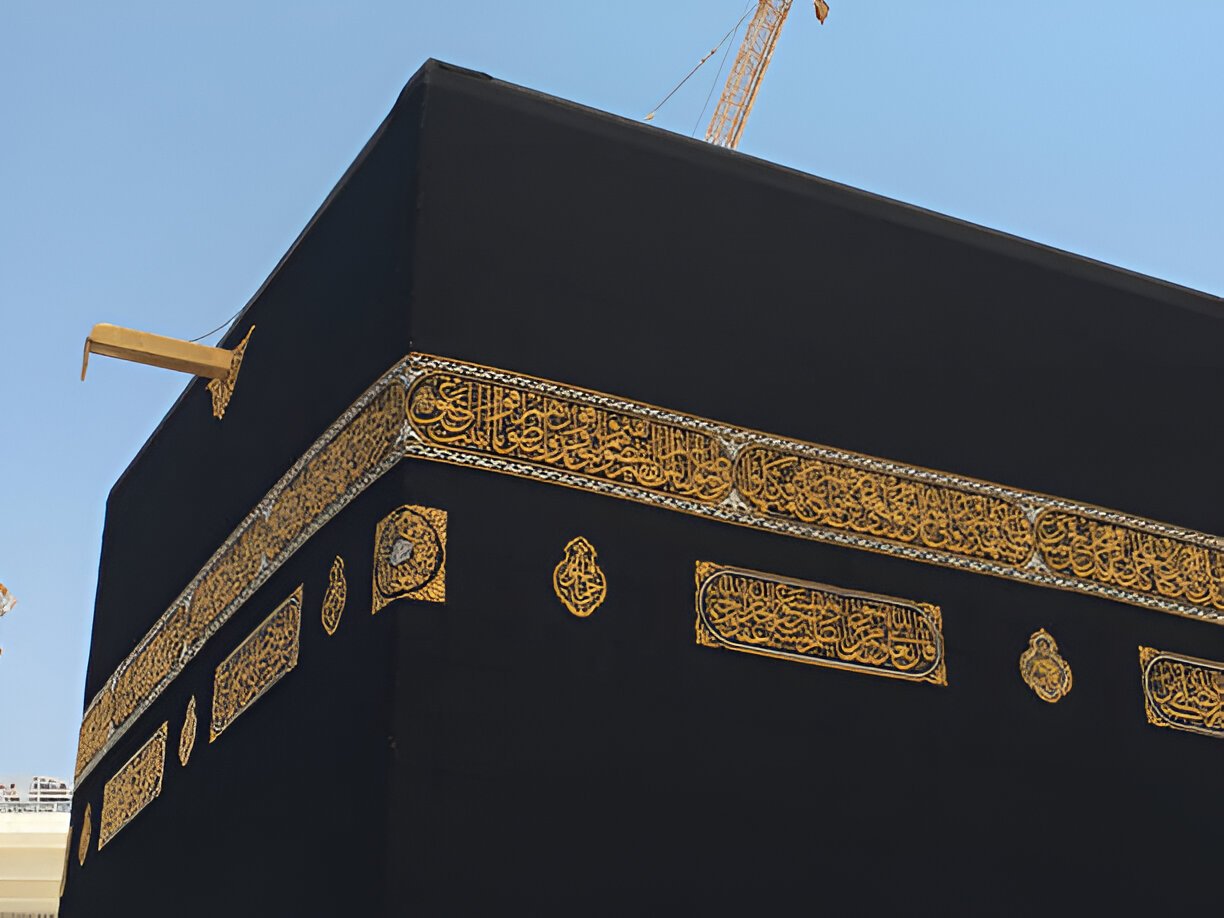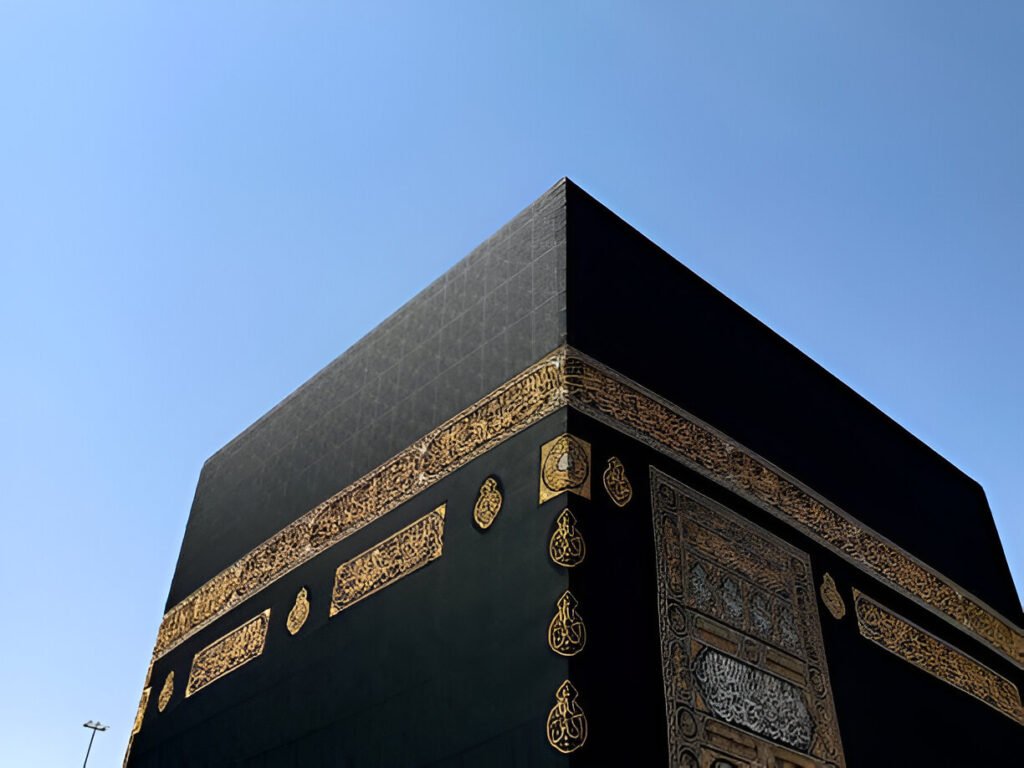The History of the Kiswa of the Ka’bah
The Kiswa of the Ka’bah is a brilliant symbol of showing utmost respect for the House of Allah. It is a real example of the servant’s sincere efforts to adorn the House of Allah. The history of the Kiswa of the Ka’bah actually begins with the history of the Ka’bah itself. According to some scholars, it was none other than Hazrat Ismail (AS) who first draped the Kiswa on the Ka’bah. However, another historical account mentions that the first to place the Kiswa on the Ka’bah was the ruler of Yemen, Tubb’a. During the reign of the Khuzā’ah tribe in Makkah, the first Tubb’a, along with his soldiers, came to destroy the Ka’bah but ended up being destroyed himself. After that, the second Tubb’a tried to destroy the Ka’bah but was defeated by the Quraysh. Then came the third Tubb’a, known as Tubb’a Al-Humayri, who moved forward to destroy the Ka’bah and plunder its treasures. However, he and his soldiers suddenly faced a mighty storm and were forced to retreat.
They were struck by a severe illness, which was seen as the wrath of Allah. The religious scholar accompanying him advised the king to stop the campaign, to show respect for the Ka’bah, perform its Tawaf, and shave his head. Consequently, the king accepted the advice and stayed in Makkah for six days. During this time, he gathered the finest and most luxurious fabrics to make the Kiswa and draped it on the Ka’bah. For this reason, Tubb’a Al-Humayri is considered the first person to drape the Kiswa on the Ka’bah. His full name was Tubb’a As’ad Abu Karab Al-Humayri. However, some historians believe that the first to drape the Kiswa on the Ka’bah was the Prophet Muhammad’s ancestor, Adnan bin Ud.
Among these two opinions, the event where Tubb’a Al-Humayri placed the first Kiswa on the Ka’bah is considered to be more reliable. Tubb’a Al-Humayri initially made the Kiswa using thick cloth. Later, he used fabrics known as Ma’afir, Mala, and Usayil to make the Kiswa. During the period of Jahiliyyah, many people draped the Kiswa on the Ka’bah, considering it a religious obligation. Any person could drape the Kiswa at any time if they wished. The Kiswa fabric was famous Yemeni cloth, silk, Iraqi silk, and the renowned Egyptian Kabaati cloth, among others. Often, one Kiswa would be draped over another. When the Kiswa became heavy or old, it would be removed and buried. A notable incident regarding this is that Abu Rabi’ah bin Abdullah bin ‘Amr Al-Makhzumi, a wealthy man, proposed to the Quraysh that one year he would fund the Kiswa for the Ka’bah, and in the following year, all the Quraysh would contribute. The Quraysh leaders accepted this proposal, and this practice continued as long as Rabi’ah lived.
After the Conquest of Makkah, the Kiswa of the Ka’bah was maintained by the Prophet Muhammad (PBUH). Once, when a woman was applying perfume to the Ka’bah, the Kiswa caught fire and was burned. The Prophet Muhammad (PBUH) then draped a new Kiswa made from Yemeni fabric on the Ka’bah.
During the reign of the Rashidun Caliphs, Hazrat Abu Bakr, Umar, and Uthman (RA) made the Kiswa using the famous Kabaati fabric from Egypt and draped it on the Ka’bah. There is no evidence that Hazrat Ali (RA) ever draped a Kiswa on the Ka’bah. It is likely that due to his involvement in wars, he was unable to attend to this matter.
The Continuation of Draping the Kiswa
Hazrat Muawiyah bin Abu Sufyan (RA) would drape the Kiswa on the Ka’bah twice a year. The first time on Ashura, the 10th of Muharram, using silk Kiswa, and the second time at the end of Ramadan with Kabaati fabric from Egypt. His son Yazid continued this practice, followed by Hazrat Abdullah bin Zubair (RA) and Abdul Malik bin Marwan. They too used silk cloth to drape the Kiswa. Due to the repeated layering of Kiswa, its weight increased, raising the risk of the Ka’bah’s walls collapsing. In 160 AH, when Caliph Mahdi came for Hajj, he issued a decree that only one Kiswa could be draped on the Ka’bah at any given time. This rule remains in effect to this day. However, the Abbasid Caliph Mamun would drape the Kiswa on the Ka’bah three times a year. The first time, on the 8th of Dhu al-Hijjah, using red silk Kiswa; the second on the 1st of Rajab using white Kabaati cloth from Egypt; and the third on the 29th of Ramadan with silk Kiswa. After the Crusades, the famous leader Salahuddin Ayyubi’s contemporary Abbasid Caliph al-Nasir li-Din Allah initially covered the Ka’bah with a green covering and later with a black one. Since then, a black covering has always been used for the Ka’bah.
After the end of the Abbasid rule, it was the ruler of Egypt, Sultan al-Zahir Baybars, who placed the covering on the Ka’bah. Then, in 659 Hijri, the ruler of Yemen, al-Mujaffar, also placed a covering. Afterward, the rulers of Egypt and Yemen gradually took turns in placing the covering on the Ka’bah.
Design of the Covering
In 810 Hijri, the first decorative covering with designs was placed on the Ka’bah door, and it was called ‘Burqa.’. From 816 to 818, this decorated Burqa method was paused, but in 819 Hijri, it resumed with decorated and carved coverings, a practice that continues to this day.
The Color of the Covering
In 751 Hijri, the pious ruler of Egypt, Ismail bin Nasir Muhammad bin Qalun, announced a special endowment for making the covering for the Ka’bah. From this endowment, every year, an external black covering and an internal red covering were made for the Ka’bah. And every five years, a green covering was made for the Hujra-tul-Nabi in Madinah. However, at the beginning of the 13th century Hijri, the Egyptian ruler Muhammad Ali Pasha abolished this endowment and started funding the Ka’bah’s covering from the government treasury. He assigned the responsibility of making the internal covering of the Ka’bah and the covering for the Hujra-tul-Nabi to the Ottoman rulers of Turkey. The right to make the external covering of the Ka’bah was left to the government of Egypt. This system continued until the Saudi government’s rule.
Regarding the color of the Ka’bah’s covering, the famous Islamic scholar Allama Ahmad Abdul Ghafoor Attar writes in his book Al-Ka’bah Wal-Kiswa that the color of the Ka’bah and its covering has varied throughout history. It was never the same for long. During the Abbasid rule, black was their national color, and it was used in every state-related matter. Therefore, the Abbasid Caliph al-Nasir li-Din Allah first used black cloth for the Ka’bah’s covering. He passed away in 622 Hijri, and since then, this black color has not been changed.
Now, we will discuss the different colors of the coverings placed on the Ka’bah at various times.
Mainly, Yemenite Burood, Egyptian Kabati, and Khurasani silk were used for making the Ka’bah’s covering. برود يمنية refers to Yemen’s distinctive fabric. القباطي refers to the famous and valuable cloth made in Egypt. الخصف والخصاف is a coarse fabric. الملا is a thin cloth. A single piece of cloth was used to make this. المعافر refers to a city in Yemen, and its cloth was of very high quality. العصب refers to Yemen’s cloth, made by blending colored threads with white thread. الموح is a thick woolen fabric. الانطاع refers to leather-made bedding, which was also used to make the Ka’bah’s covering. The third Tubbah of Yemen, Al-Humayri, used these fabrics to make the Ka’bah’s covering.
الحبرات refers to a cloth made by a pious Quraysh person named Abu Rabi’ah al-Makhzumi. This cloth was entirely made of thread and was made in Yemen.
الأنماط refers to woolen cloth of various colors, which was generally used for covering camel saddles.
المطارف refers to a four-cornered blanket or cloth.
Hazrat Zayed bin Sabit Ansari (RA) saw the Ka’bah’s covering made of green and yellow مطارف cloth, woolen cloth, and کار fabric.
الكار is a type of special cloth.
الثَّمَارِقُ refers to pillows. Some say it refers to bedding, while others claim it refers to special cloth.
الوصائل refers to Yemen’s red-dora fabric.
Umar bin Hakim al-Sulami said that he saw the Ka’bah’s covering made of نَمَارق and وَصَائِلُ fabrics.
الفز is pure silk produced from silkworms.
القبلان is coarse fabric.
The Prophet Muhammad (PBUH) himself used Yemenite fabric to cover the Ka’bah. Hazrat Abu Bakr, Umar, and Uthman (RA) used Egyptian Kabati and Yemenite Burood fabrics for the Ka’bah’s covering. Khalid bin Jafar bin Kelab bin Murrah used Dibaj to make the Ka’bah’s covering. Hazrat Abdullah bin Zubair (RA) used Khurasani Dibaj to cover the Ka’bah. That dibaj was in red, green, white, and yellow colors. Hussein Akatas al-Alawi made two coverings using pure silk from silkworms—one yellow and the other white. Abdul Aziz’s son Saud al-Qabir in 1221 Hijri used pure silkworm silk and Qilan (coarse cloth) for the Ka’bah’s covering. The above discussion applies to the covering on the outer walls of the Ka’bah. An inner covering is also placed, and it comes in various colors, such as black, red, green, and other colors.
 The Ka’bah Kiswa Manufacturig Factory
The Ka’bah Kiswa Manufacturig Factory
After the beginning of the Saudi government’s rule, King Abdul Aziz Al-Saud ordered the establishment of a special Kiswa manufacturing factory in Makkah in the month of Muharram, 1346 Hijri. By mid-year, the factory for making the Kiswa was established. This was the first effort to make the Ka’bah Kiswa in Makkah. The factory continued to produce the Kiswa until 1357 Hijri. With the aim of further enhancing the sanctity of the Ka’bah, in 1382 Hijri, King Faisal bin Abdul Aziz ordered the modernization of the factory.
Therefore, in 1397 Hijri, a new, more advanced factory was established in a building in Ummul Jud, Makkah. The factory adopted mechanical weaving methods for fabric. However, the art of craftsmanship was preserved and continued. This factory produces a beautiful Kiswa for the Ka’bah every year, and currently, 240 employees work there. The factory consists of six departments: 1. Belt Department; 2. Handicraft Department; 3. Mechanical Department; 4. Printing Department; 5. Dyeing Department; 6. Internal Curtain Department.
 Description of the Current Kiswa
Description of the Current Kiswa
The Ka’bah Kiswa is made from pure natural silk. The silk is dyed black. Then, phrases such as “La Ilaha Illallah Muhammadur Rasulullah,” “Allahu Jalla Jalaluhu,” “Subhanallah wa bihamdihe,” and “Subhanallahil Azim” are embroidered in the Kiswa using the Zaka method. The height of the Kiswa is 14 meters. On the upper third of it, a 95-centimeter-wide belt is made, and the three-lettered Quranic verses are written in the frame of the belt. The frame is decorated with Islamic calligraphy and embroidered using silver wires coated in gold. This belt surrounds the Ka’bah. The total length of the belt is 47 meters, and it is divided into 16 pieces. Beneath the belt, the Quranic verses are written in separate frames at each corner. In the middle, words like “Ya Hayyu Ya Qayyumu,” “Ya Rahmanu Ya Rahimu,” or “Alhamdulillahi Rabbil Alameen” are written to create spacing between the verses. All the writings beneath the belt are linked in a three-lettered fashion, embroidered with suitable needlework, and golden and silver thin wires are attached to them. Since the Saudi rule, gold has been used in the Ka’bah Kiswa’s decoration. Additionally, there are 11 designs of the symbol of a candle in the Kiswa. These are attached to the four corners of the Ka’bah.
The curtain of the Ka’bah door is called “Burqa.” It is also made of black silk. Its height is 7.5 meters, and its width is 4 meters. It too reflects Islamic designs and calligraphy, with Quranic verses embroidered in thin gold and silver wires.
The Ka’bah’s door and the outer Kiswa are made from strong silk fabric. Five pieces of the Kiswa are made in total. Four pieces are for the four sides, and the fifth piece is attached to the door. The pieces are sewn together. Each year, when the new Kiswa is placed, the old one is removed.
The current Kiswa requires 670 kg of silk and 150 kg of gold and silver thin wires. The total area of the Kiswa is 658 square meters, made from 47 bolts of silk fabric. Each bolt is 1 meter long and 95 centimeters wide. They are sewn together one by one. Four years ago, it was decided to make two Kiswa each year (one as a precautionary measure). One is handmade, taking 8-9 months, while the other is machine-made, taking just one month. A piece of the Kiswa is also made for the Hujra of the Prophet and for gifting purposes. The length of the inner curtain of the Kiswa is 7 meters, and its width is 4 meters. Quranic verses are drawn on it with thin gold and silver wires. The entire Kiswa, belt, and internal curtain consist of 16 pieces, with Quranic verses embroidered in gold. These 16 pieces are 47 meters long and 95 centimeters wide.
Every year, on the 9th of Dhu al-Hijjah, the new Kiswa is placed on the Ka’bah. This day coincides with the day of Hajj. The pilgrims are in the plain of Arafat, and the number of worshippers in the Masjid al-Haram is very low. Nowadays, the Kiswa is placed on the Ka’bah on the day of Hajj and also for the Hajj season. The pilgrims returning from Arafat see the new Kiswa on the Ka’bah.
After the Kiswa is made in the factory, it is handed over to the caretaker of the Ka’bah, from the Banu Shaybah tribe, before being placed on the Ka’bah. With his approval, the Kiswa is then placed on the Ka’bah with the help of all concerned parties.
A few days before Hajj, the lower part of the Ka’bah’s Kiswa is lifted upwards, and the outer part of the Ka’bah’s walls becomes visible and can be touched.



